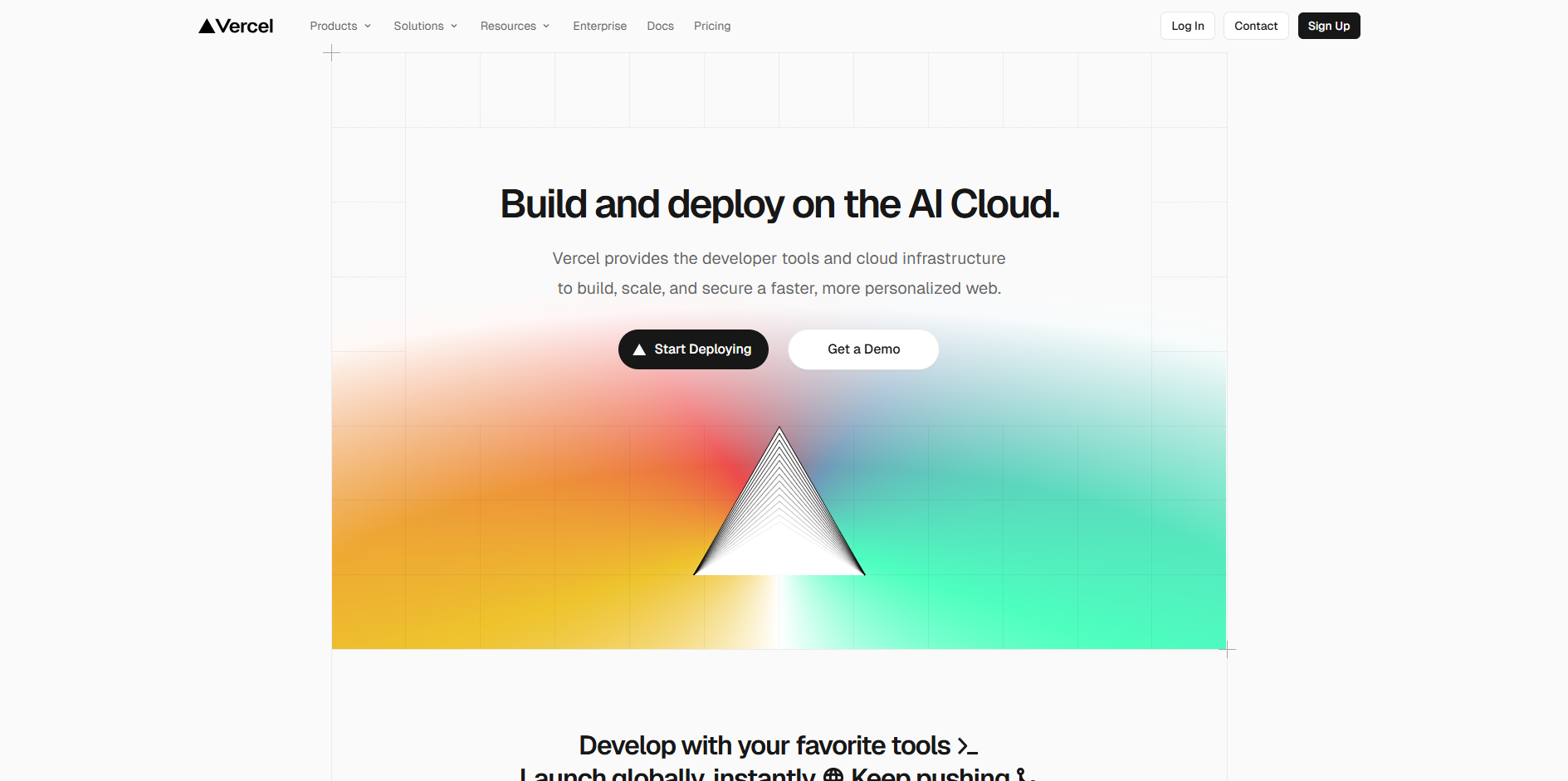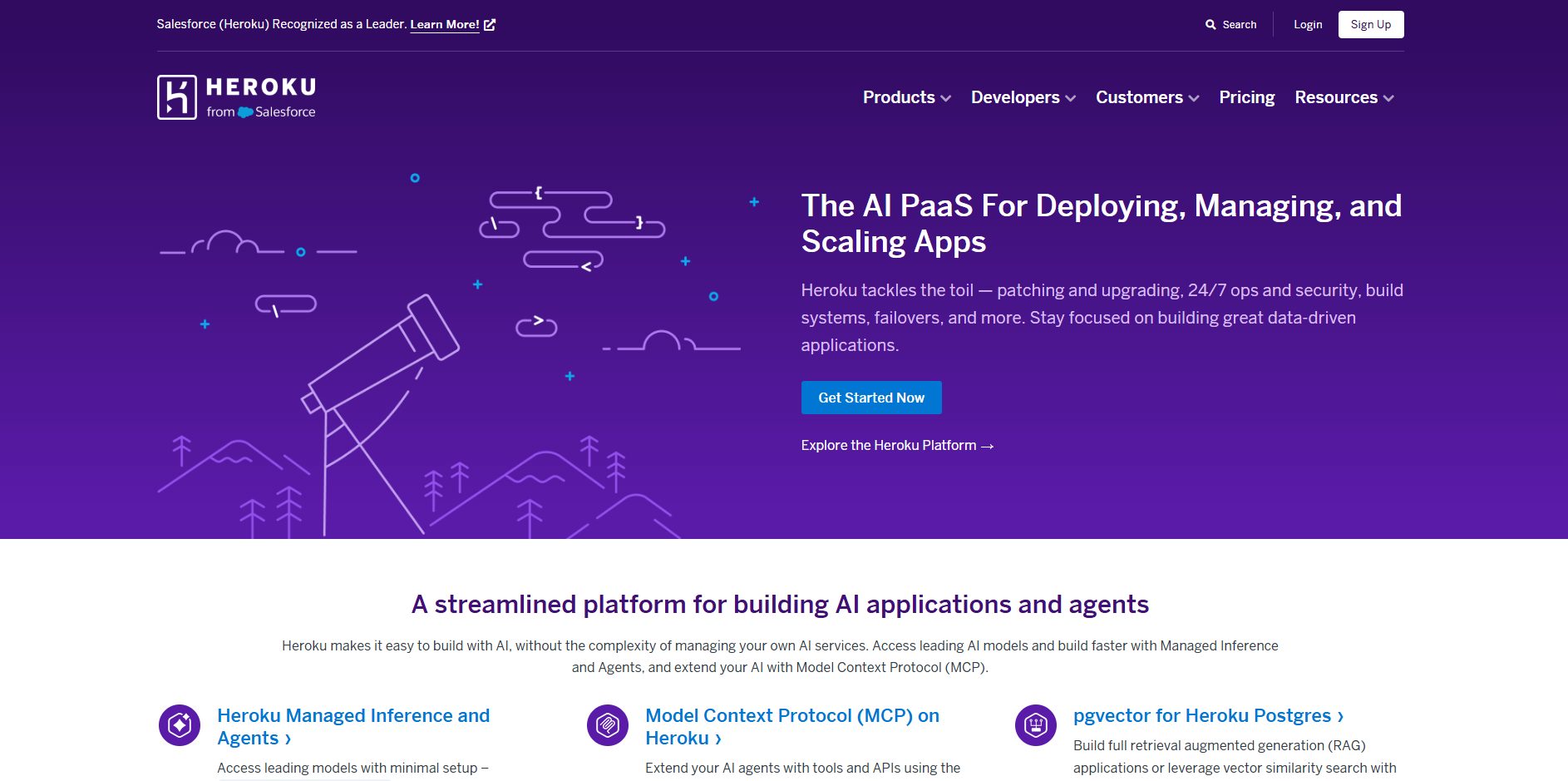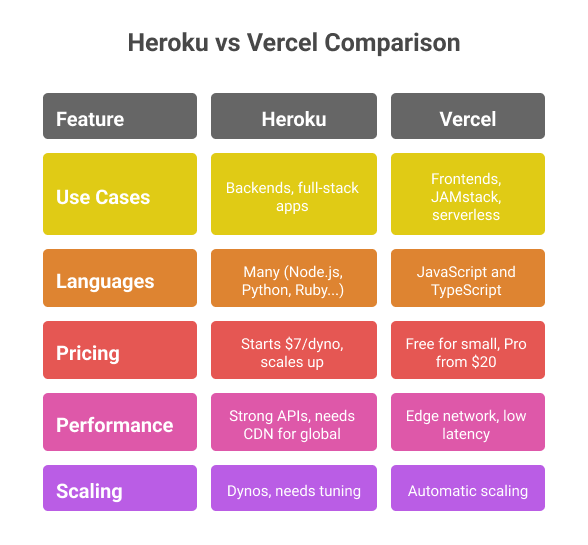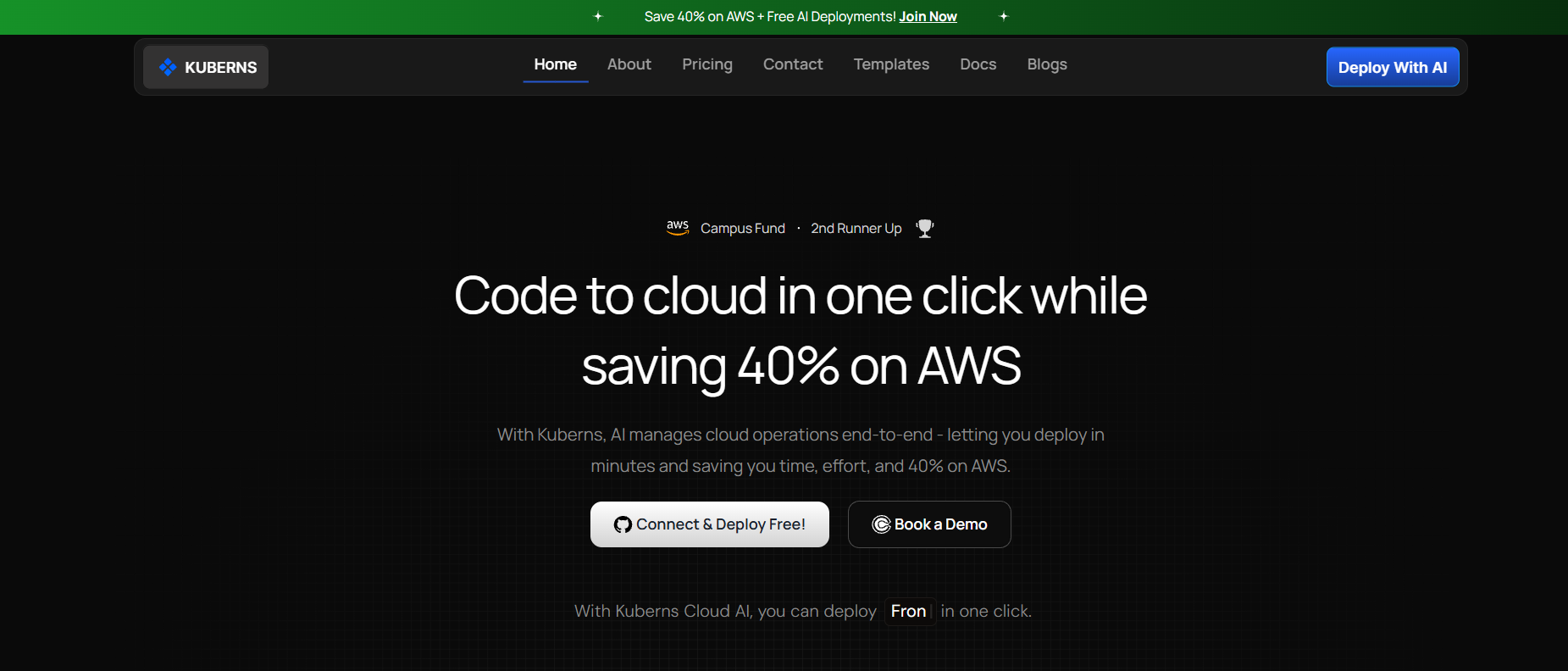Published
- 9 min read
Heroku vs Vercel: Which Platform Should You Choose in 2025?

Introduction
When you are building and deploying an application, the choice of platform directly affects how fast you ship, how well your app scales, and how much you spend over time. Two names that developers often compare are Heroku and Vercel. Both simplify deployment, but they serve different goals. Heroku is better known for backend applications and multi-language support, while Vercel is focused on frontend frameworks and serverless workloads.
This blog looks at Heroku vs Vercel in detail. You will learn what each platform does, how they differ in pricing, performance, and features, and which types of projects they fit best. Along the way, we will also highlight how Kuberns brings together the strengths of both by offering a single platform for deploying full-stack applications with AI-driven scaling and cost efficiency. If you want a broader view of Kuberns, you can start with this guide: What Is Kuberns: The Simplest Way to Build, Deploy, and Scale Full-Stack Apps.
What Is Vercel?
 Vercel is a platform designed for frontend-first and serverless deployments. It is tightly integrated with frameworks like Next.js, React, and Svelte, making it a popular choice for developers who prioritize speed and global reach. The platform simplifies deployment with built-in CI/CD pipelines and automated scaling, which makes it attractive for teams focused mainly on static sites or frontend-heavy applications. However, its scope is narrower when it comes to backend-driven projects or multi-language support.
Vercel is a platform designed for frontend-first and serverless deployments. It is tightly integrated with frameworks like Next.js, React, and Svelte, making it a popular choice for developers who prioritize speed and global reach. The platform simplifies deployment with built-in CI/CD pipelines and automated scaling, which makes it attractive for teams focused mainly on static sites or frontend-heavy applications. However, its scope is narrower when it comes to backend-driven projects or multi-language support.
For teams looking at a broader approach that goes beyond frontend hosting, it is worth reviewing how Vercel compares with Kuberns. Kuberns provides the same simplicity for frontend frameworks but also supports full-stack deployments with integrated CI/CD, monitoring, and up to 40% AWS cost savings, making it a more versatile option for projects that need both frontend and backend scalability.
What Is Heroku?
 Heroku is one of the earliest Platform as a Service providers that made it easier for developers to deploy and scale applications. It supports several languages such as Node.js, Python, Ruby, Java, PHP, and Go. Applications run on containers called dynos, and developers can deploy code directly through Git. The platform also offers a marketplace of add-ons for databases, caching, and monitoring, which makes it useful for building full-stack applications and APIs.
Heroku is one of the earliest Platform as a Service providers that made it easier for developers to deploy and scale applications. It supports several languages such as Node.js, Python, Ruby, Java, PHP, and Go. Applications run on containers called dynos, and developers can deploy code directly through Git. The platform also offers a marketplace of add-ons for databases, caching, and monitoring, which makes it useful for building full-stack applications and APIs.
Heroku is still valued for its simplicity, especially by startups and small teams, but its pricing and scaling limitations have become challenges for larger or growing projects. Teams exploring modern options often look at Heroku vs Kuberns, since Kuberns provides the same easy workflow with Git-based deployments while adding AI-driven scaling, integrated monitoring, and lower cloud costs.
Heroku vs Vercel: Key Differences
 Heroku and Vercel both simplify deployment, but they are designed for different purposes. Understanding these differences will help you choose the right platform for your project.
Heroku and Vercel both simplify deployment, but they are designed for different purposes. Understanding these differences will help you choose the right platform for your project.
1. Supported Use Cases
Heroku is widely used for backend-heavy projects such as APIs, databases, and full-stack apps. It supports background jobs and persistent data storage, which makes it attractive to startups and backend teams.
- Strong for APIs and multi-service apps
- Works well for projects needing persistent connections
- Often used by small teams scaling to production
Vercel is tailored for frontend-first development. It fits JAMstack sites, static websites, and modern JavaScript applications. Backend logic is handled through serverless functions.
- Optimized for Next.js, React, and static site generation
- Best for frontend-heavy projects with global audiences
- Backend tasks are short-lived and function-based
2. Language and Framework Support
Heroku supports multiple programming languages out of the box.
- Node.js, Python, Ruby, Java, PHP, Go, Scala
- Flexible for teams working across different stacks
Vercel focuses on JavaScript and TypeScript.
- First-class integration with Next.js
- Strong support for React, Svelte, and other JS frameworks
- Limited for teams working outside the JS ecosystem
3. Pricing
Heroku pricing starts at $7 per month for a single dyno, but real-world apps usually need more dynos plus add-ons.
- Add-ons for databases, caching, and monitoring increase costs
- Expenses rise quickly as traffic and services grow
Vercel offers a free tier for small projects. Paid plans begin at $20 per user per month.
- Costs tied to serverless function usage, bandwidth, and storage
- Can get expensive for larger teams or high-traffic apps
4. Performance
Heroku is stable for backend workloads but relies on CDNs for faster global delivery.
- Good for backend APIs and services
- Global performance requires external setup
Vercel is built on a global edge network, ensuring low-latency delivery.
- Fast static content delivery worldwide
- Serverless functions scale across regions automatically
5. Scaling
Heroku uses dynos for scaling.
- Easy to add dynos, but requires manual tuning
- Balancing cost and performance can be tricky
Vercel scales automatically with traffic.
- Frontend deployments and serverless functions adjust instantly
- No manual setup required for scaling
Limitations of Each
Both Heroku and Vercel simplify deployment, but each comes with limitations that can affect long-term use.
Heroku Heroku works well for backend-heavy applications, but the costs grow quickly as you add dynos and paid add-ons for databases, caching, or monitoring. Free dynos also suffer from cold starts, which makes apps feel slow after periods of inactivity. Another drawback is that it does not prioritize frontend performance, so global delivery usually requires setting up additional CDNs.
Vercel Vercel is excellent for frontend frameworks, yet its focus is narrow. It only supports JavaScript and TypeScript, which leaves out teams working with other languages like Python or Ruby. Pricing also scales with team size, bandwidth, and serverless usage, which makes costs less predictable. For backend-heavy projects, Vercel is not ideal because it lacks support for persistent connections or background jobs.
For teams that want the simplicity of Heroku and the frontend speed of Vercel without these trade-offs, Kuberns offers a more balanced approach. It supports both frontend and backend workloads in one place, provides AI-driven scaling, and helps cut cloud costs by up to 40 percent.
Why Kuberns Is a Better Alternative
 Heroku and Vercel solve parts of the deployment problem, but both leave gaps. Kuberns fills those gaps by giving you one platform for full-stack deployment that is simple, flexible, and cost-efficient.
Heroku and Vercel solve parts of the deployment problem, but both leave gaps. Kuberns fills those gaps by giving you one platform for full-stack deployment that is simple, flexible, and cost-efficient.
Where Kuberns Stands Out
- Supports both frontend and backend workloads, not limited to one side
- Built-in CI/CD, monitoring, and logs without extra setup
- AI-driven scaling that adjusts automatically with traffic
- Up to 40% savings on AWS infrastructure costs
With this approach, Kuberns combines the ease of Heroku with the speed of Vercel, while avoiding the high costs and narrow scope of both.
Conclusion
Choosing between Heroku and Vercel depends on your project needs. Heroku is a good fit for backend-heavy applications and multi-language support, while Vercel excels in frontend-first deployments with global edge delivery. Both platforms make deployment easier, but they also come with limitations in cost, scaling, and flexibility.
If you are looking for a platform that combines the simplicity of Heroku with the performance of Vercel, while removing the trade-offs, Kuberns is the smarter choice. It supports both frontend and backend workloads, provides built-in CI/CD and monitoring, uses AI to scale automatically, and helps you save up to 40% on AWS infrastructure costs.
Start building without the limitations of separate tools. Try Kuberns today and experience a simpler way to deploy and scale your applications.

FAQ
Q. Is Heroku still good in 2025? Yes, but costs can be high for scaling teams.
Q. Is Vercel only for frontend apps? Mostly, but it handles serverless backends too.
Q. Can I use Heroku and Vercel together? Yes. You can host your backend on Heroku and frontend on Vercel.
Q. What is the best alternative to Heroku or Vercel? The best alternative is Kuberns, a platform that supports both frontend and backend workloads in one place. Unlike Heroku, it delivers cost efficiency with up to 40 percent AWS savings, and unlike Vercel, it is not limited to JavaScript frameworks. Kuberns includes integrated CI/CD, monitoring, and AI-driven scaling, giving teams a simpler and more affordable way to deploy full-stack applications.